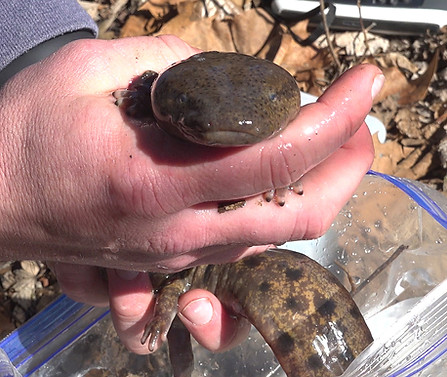ALL ABOUT MUDPUPPIES

Mudpuppy at Allerton Park, Monticello, IL. Photo by Alex Lourash
You'd never expect to find such an unusual creature in the rivers and lakes of the Midwest! The mudpuppy salamander is unique in many ways.
Mudpuppies Love Water
Most salamanders live in the water only when they’re young. As they mature, they grow lungs and move onto land. But mudpuppies (Latin name Necturus maculosus) never grow lungs. They live their whole lives in the water, breathing with their unusual fluffy red external gills.
Mudpuppies Are Oversized
Mudpuppies can be up to 16 inches long and weigh as much as a pound! The average salamander is only about 6 inches long.

A mudpuppy underwater, with red gills fully fluffed out. Photo by Cullen Hanks, Wikimedia

Mudpuppy at Allerton Park, Monticello, IL Photo by Roger Inman
Mudpuppies Are Toe-tally Unique
Most salamanders have five toes on their hind feet; mudpuppies have four!
Mudpuppies Are Like Uber Drivers
Freshwater mussels can't move, so they need a ride to reach new territory. When they're young, tiny mussels (called glochidia) hitch a ride on a fish. After they mature, they let go of the fish and start life in a new location.
But mussels are picky; they'll only catch a ride with their favorite kinds of fish. And the salamander mussel is even more picky; it only rides on a mudpuppy! The mudpuppy is the only non-fish animal that helps mussels in this way.
Looking for Mudpuppies in the Sangamon River:
Mudpuppy Survey Video
Watch this video for great closeups of those elusive mudpuppies. See how researchers in Central Illinois are keeping track of the mudpuppies living in the Sangamon River.
Read more about the Mudpuppy Survey project in Outdoor Illinois Journal.

Where do mudpuppies live?
Mudpuppies live in rivers, lakes, and ponds. They’re found in Wisconsin and Michigan, down through Illinois, Indiana, and Ohio, and as far south as Kentucky and Tennessee. This map shows their range.
If a river or lake has mudpuppies, that’s a sign that the water is clean! Mudpuppies are an “indicator species” because they can show how healthy the environment is.
Why are they called mudpuppies?
Some people say that mudpuppies make a barking sound. They’re also called waterdogs.
Why haven't I seen a mudpuppy?
Mudpuppies don't want to be seen! They hide among rocks or roots during the day and hunt for food at night.
Mudpuppies stay active in winter. Sometimes ice fishermen find mudpuppies by accident (and return them to the water).
Winter is when scientists trap mudpuppies to study them. Mudpuppies have a slimy coating that helps to protect them.
How can they find food in the dark?
Mudpuppies use their sense of smell to find food. They will eat almost anything they can find, including insects, mollusks, worms, and small fish.

Land Conservation Foundation Advisor Fran Harty holds a mudpuppy at LCF's
Sangamon River Corridor Reserve. Photo by Nate Beccue

These are axolotls, not mudpuppies! Photo by Emoke Dénes, Wikimedia
Can I keep a mudpuppy?
Not in Illinois, where mudpuppies are a threatened species. There aren't many of them in the wild, so it's against the law to own one.
But haven't I seen one in an aquarium?
You sure "axolotl" questions! You may have seen an axolotl salamander (Latin name: Ambystoma mexicanum). Some people keep them as pets. Like mudpuppies, axolotls live only in the water and have fluffy gills. But they are not closely related to mudpuppies. Axolotls in the wild are so rare they are considered critically endangered. They live in just one lake, near Mexico City.
The Land Conservation Foundation's annual Mudpuppy Festival celebrates the mudpuppy and other wildlife in East Central Illinois, where the Land Conservation Foundation works to preserve and restore natural lands, especially along rivers.

